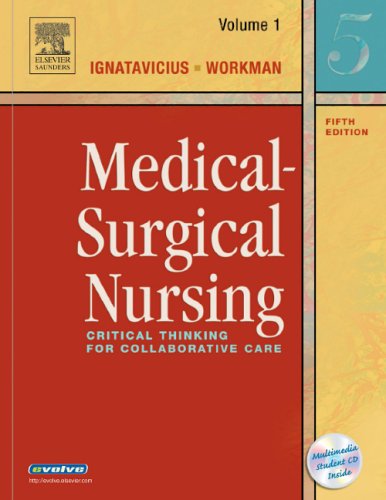Medical-Surgical Nursing: Critical Thinking for Collaborative Care
$50.00 Original price was: $50.00.$25.00Current price is: $25.00.
Medical-Surgical Nursing: Critical Thinking for Collaborative Care – Digital Instant Dowload.
Medical-Surgical Nursing: Critical Thinking for Collaborative Care – Digital Instant Dowload.

Product details:
- ISBN-10 : 0721687628
- ISBN-13 : 978-0721687629
- Author: Donna D. Ignatavicius and M. Linda Workman
Medical-Surgical Nursing: Critical Thinking for Collaborative Care is a comprehensive yet eminently readable undergraduate textbook of medical-surgical/adult health nursing that addresses the very latest trends in nursing care of adults. Revised after just three years, it incorporates both NIC intervention categories and outcome statements that are consistent with NOC outcome indicators, as well as enhanced coverage of complementary and alternative therapies, community-based care, cultural diversity, substance abuse, evidence-based practice, Healthy People 2010 goals, and cost-of-care implications for nursing. Together with a thoroughly revised Critical Thinking Study Guide, an innovative Instructor’s Manual, and a groundbreaking new Virtual Clinical Excursions web-based learning experience, the 4th edition of “Iggy” moves to the forefront of nursing education as a fully integrated multimedia instructional package for mediacl-surgical nursing.
Table contents:
UNIT I. HEALTH PROMOTION AND ILLNESS
1. Critical Thinking in the Role of the Medical-Surgical Nurse
2. Community-Based Care
3. Introduction to Managed Care and Case Management
4. Introduction to Complementary and Alternative Therapies in Nursing
5. Health Care of Older Adults
UNIT II. BIOPSYCHOSOCIAL CONCEPTS RELATED TO HEALTH CARE
6. Cultural Aspects of Health
7. Pain: The Fifth Vital Sign
8. Substance Abuse
9. End-of-Life Care
10. Rehabilitation Concepts for Acute and Chronic Problems
11. Genetic Concepts for Medical-Surgical Nursing NEW!
UNIT III. CONCEPTS OF EMERGENCY NURSING NEW!
12. Emergency and Mass Casualty Nursing NEW!
13. Interventions for Clients with Common Environmental Emergencies NEW!
UNIT IV. MANAGEMENT OF CLIENTS WITH FLUID, ELECTROLYTE, AND ACID-BASE IMBALANCES
14. Fluid and Electrolyte Balance
15. Interventions for Clients with Fluid Imbalances
16. Interventions for Clients with Electrolyte Imbalances
17. Infusion Therapy
18. Acid-Base Balance
19. Interventions for Clients with Acid-Base Imbalances
UNIT V. MANAGEMENT OF PERIOPERATIVE CLIENTS
20. Interventions for Preoperative Clients
21. Interventions for Intraoperative Clients
22. Interventions for Postoperative Clients
UNIT VI. PROBLEMS OF PROTECTION: MANAGEMENT OF CLIENTS WITH PROBLEMS OF THE IMMUNE SYSTEM
23. Concepts of Inflammation and the Immune Response
24. Interventions for Clients with Connective Tissue Disease and Other Types of Arthritis
25. Interventions for Clients with HIV/AIDS and Other Immunodeficiencies
26. Interventions for Clients with Immune Function Excess: Hypersensitivity (Allergy) and Autoimmunity
27. Altered Cell Growth and Cancer Development
28. General Interventions for Clients with Cancer
29. Interventions for Clients with Infection
UNIT VII. PROBLEMS OF OXYGENATION: MANAGEMENT OF CLIENTS WITH PROBLEMS OF THE RESPIRATORY TRACT
30. Assessment of the Respiratory System
31. Interventions for Clients Requiring Oxygen Therapy or Tracheostomy
32. Interventions for Clients with Noninfectious Problems of the Upper Respiratory Tract
33. Interventions for Clients with Noninfectious Problems of the Lower Respiratory Tract
34. Interventions for Clients with Infectious Problems of the Lower Respiratory Tract
35. Interventions for Critically Ill Clients with Respiratory Problems
UNIT VIII. PROBLEMS OF CARDIAC OUTPUT AND TISSUE PERFUSION: MANAGEMENT OF CLIENTS WITH PROBLEMS OF THE CARDIOVASCULAR SYSTEM
36. Assessment of the Cardiovascular System
37. Interventions for Clients with Dysrhythmias
38. Interventions for Clients with Cardiac Problems
39. Interventions for Clients with Vascular Problems
40. Interventions for Clients with Shock
41. Interventions for Critically Ill Clients with Acute Coronary Syndromes
UNIT IX. PROBLEMS OF TISSUE PERFUSION: MANAGEMENT OF CLIENTS WITH PROBLEMS OF THE HEMATOLOGIC SYSTEM
42. Assessment of the Hematologic System
43. Interventions for Clients with Hematologic Problems
UNIT X. PROBLEMS OF MOBILITY, SENSATION, AND COGNITION: MANAGEMENT OF CLIENTS WITH PROBLEMS OF THE NERVOUS SYSTEM
44. Assessment of the Nervous System
45. Interventions for Clients with Problems of the Central Nervous System: The Brain
46. Interventions for Clients with Problems of the Central Nervous System: The Spinal Cord
47. Interventions for Clients with Problems of the Peripheral Nervous System
48. Interventions for Critically Ill Clients with Neurologic Problems
UNIT XI. PROBLEMS OF SENSATION: MANAGEMENT OF CLIENTS WITH PROBLEMS OF THE SENSORY SYSTEM
49. Assessment of the Eye and Vision
50. Interventions for Clients with Eye and Vision Problems
51. Assessment of the Ear and Hearing
52. Interventions for Clients with Ear and Hearing Problems
UNIT XII. PROBLEMS OF MOBILITY: MANAGEMENT OF CLIENTS WITH PROBLEMS OF THE MUSCULOSKELETAL SYSTEM
53. Assessment of the Musculoskeletal System
54. Interventions for Clients with Musculoskeletal Problems
55. Interventions for Clients with Musculoskeletal Trauma
UNIT XIII. PROBLEMS OF DIGESTION, NUTRITION, AND ELIMINATION: MANAGEMENT OF CLIENTS WITH PROBLEMS OF THE GASTROINTESTINAL SYSTEM
56. Assessment of the Gastrointestinal System
57. Interventions for Clients with Oral Cavity Problems
58. Interventions for Clients with Esophageal Problems
59. Interventions for Clients with Stomach Disorders
60. Interventions for Clients with Noninflammatory Intestinal Disorders
61. Interventions for Clients with Inflammatory Intestinal Disorders
62. Interventions for Clients with Liver Problems
63. Interventions for Clients with Problems of the Biliary System and Pancreas
64. Interventions for Clients with Malnutrition and Obesity
UNIT XIV. PROBLEMS OF REGULATION AND METABOLISM: MANAGEMENT OF CLIENTS WITH PROBLEMS OF THE ENDOCRINE SYSTEM
65. Assessment of the Endocrine System
66. Interventions for Clients with Pituitary and Adrenal Gland Problems
67. Interventions for Clients with Problems of the Thyroid and Parathyroid Glands
68. Interventions for Clients with Diabetes Mellitus
UNIT XV. PROBLEMS OF PROTECTION: MANAGEMENT OF CLIENTS WITH PROBLEMS OF THE SKIN, HAIR, AND NAILS
69. Assessment of the Skin, Hair, and Nails
70. Interventions for Clients with Skin Problems
71. Interventions for Clients with Burns
UNIT XVI. PROBLEMS OF EXCRETION: MANAGEMENT OF CLIENTS WITH PROBLEMS OF THE RENAL/URINARY SYSTEM
72. Assessment of the Renal/Urinary System
73. Interventions for Clients with Urinary Problems
74. Interventions for Clients with Renal Disorders
75. Interventions for Clients with Acute and Chronic Renal Failure
UNIT XVII. PROBLEMS OF REPRODUCTION: MANAGEMENT OF CLIENTS WITH PROBLEMS OF THE REPRODUCTIVE SYSTEM
76. Assessment of the Reproductive System
77. Interventions for Clients with Breast Disorders
78. Interventions for Clients with Gynecologic Problems
79. Interventions for Male Clients with Reproductive Problems
80. Interventions for Clients with Sexually Transmitted Disease
Appendix: Abbreviations
You may also like…
Uncategorized
Study Guide for Medical-Surgical Nursing: Assessment and Management of – Ebook PDF Version
Uncategorized
Medicine
Medicine - Nursing
Uncategorized
Uncategorized













